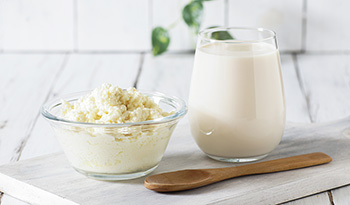How to Increase GLP-1 Naturally

As the interest in medications that help promote weight management and lower blood sugar for diabetics rises, GLP-1 has entered into the collective social awareness. What exactly is GLP-1 anyway? For those who prefer a more natural approach, are there natural ways to increase GLP-1? Learn more about GLP-1 in this article.
What Is GLP-1?
Glucagon-like peptide-1, commonly called GLP-1, is a hormone made of a short chain of amino acids. Secreted by L-cells found in the ileum of the small intestine and the large intestine, GLP-1 plays an important role in the body.
After eating, GLP-1 is secreted and begins its work in the body by causing the pancreas to secrete insulin. Insulin is a hormone that helps take glucose or blood sugar out of the bloodstream and into the cells. GLP-1 also inhibits the secretion of glucagon. Glucagon is a hormone that has the opposite effect of insulin. It helps to increase blood sugar levels in the body.
What Does GLP-1 Do In The Body?
Since GLP-1 increases insulin secretion and decreases glucagon production, it helps to lower blood sugar. GLP-1 also plays a role in slowing down the movement of food through the digestive tract. This helps to curb appetite and decrease the amount of food ingested, which is also an action of GLP-1.
A decrease in appetite coupled with less food intake may help with weight management, which is an often desired effect of those who take medications like GLP-1 agonists. These mimic the action of the hormone.
Research indicates that GLP-1 may also play a role in cardiovascular and brain health, reduce programmed cell death, and decrease inflammation.
Since the blood sugar-lowering hormone has such amazing potential, many may wonder how to increase GLP-1 naturally. Studies suggest that there may be natural ways to increase it.
Here are 8 ways that may help to increase GLP-1 in the body.
1. The Ketogenic Diet
Peaking in popularity in 2019, the ketogenic diet is a way of eating that reduces the amount of carbohydrates in the diet to induce the body to burn ketones for energy instead of glucose. While studies suggest that following a long-term ketogenic diet may be unhealthy, following the diet for shorter periods may help increase GLP-1 secretion.
For example, one longitudinal intervention study involved 31 sedentary women and men who were diagnosed as obese. The participants followed a very low-energy ketogenic diet for 8 weeks. After the 8 weeks, participants were allowed to gradually introduce their normal foods back into the diets to stabilize their weight.
The study found that after a meal, secretion of GLP-1 was increased. The participants had an average weight loss of 5%.
2. Protein
While protein is a major macronutrient responsible for building and maintaining healthy muscles, research indicates that protein intake may also help to naturally increase GLP-1.
One controlled study involved 12 healthy male participants who ingested either milk and egg protein and oleic acid or water. With water serving as the control, the intervention group consumed egg and milk protein on one occasion and oleic acid on another.
On both occasions, the group that ingested both the oleic acid and the milk and egg protein saw an increase in GLP-1 secretion. Another single-blind randomized study involved 18 women who had normal weight. The study compared the levels of GLP-1 after ingestion of a whey protein beverage versus that of maltodextrin. The study found that there was a significant increase in GLP-1 in the whey protein group compared to the maltodextrin group.
3. Increased Calcium Intake
Calcium has gained the reputation of being an important mineral for healthy teeth and bones.
One double-blind, randomized, cross-over study included 10 healthy male participants. The participants consumed 2 similar meals matched for both energy and macronutrients. The difference was in the amount of calcium in each meal.
The control meal provided 3 milligrams (mg) of calcium per kilogram (kg) or 3 mg per every 2.2 pounds (lbs) of body weight. The calcium content in the intervention group was increased to 15 mg of calcium per kg.
The study found that the high calcium group experienced a 22% increase in GLP-1 compared to the low calcium group. There was also a 19% increase in insulin secretion and a 12% increase in the feelings of appetite suppression.
4. Quality Sleep
Sleep is essential for health. Studies have linked sleep deprivation and even a lack of quality sleep to health risks like cardiovascular disease, cognitive decline, and even obesity.
Another risk of poor sleep may be a change in secretion of GLP-1. One clinical study involved 8 healthy male volunteers between the ages of 18 and 26. The study took place over 4 consecutive Fridays. The participants were placed in different conditions to promote a regular sleep schedule, sleep deprivation in the dark, sleep deprivation with light exposure at night, and sleep deprivation with filtered light exposure at night.
The study found that sleep deprivation, especially in the presence of light, not only disturbed melatonin levels but greatly disrupted GLP-1 levels and increased insulin resistance.
Since studies suggest that GLP-1 may have a circadian rhythm release pattern, losing sleep, even over a short period, may disturb GLP-1 secretion.
5. Eradicating Helicopter Pylori
Helicobacter pylori, H. pylori, is a bacteria that frequently infects the lining of the stomach and the small intestines. It is the most common cause of peptic ulcers and can cause gastritis. Some studies suggest that over 50% of the world population has an H. pylori infection.
While an H. pylori infection may result in ulcers, there is research to suggest that eliminating H. pylori from the digestive tract may increase GLP-1 levels.
One prospective case-control study involved 40 patients who had an H. pylori infection and 20 who did not. The study found that upon elimination of the H. pylori bacteria, GLP-1 secretion increased and carbohydrate metabolism improved.
The study also suggested that GLP-1 levels are associated with the gut microbiome.
6. Probiotics
Having a healthy gut microbiome is a huge contributor to overall health. Probiotics are beneficial bacteria and yeasts that are often used to support and maintain gut health. Research indicates that probiotics may also help to raise GLP-1 naturally.
One qualitative study involved over 1,000 participants with type 1 diabetes. Through diet questionnaires, the researchers found that 39% of the participants either took probiotics or consumed products rich in probiotics. Those who regularly consumed probiotics had significantly better blood sugar levels and less chance of developing metabolic syndrome than the group that didn’t.
Researchers believe that this may occur because probiotics may help to increase GLP-1 synthesis and secretion.
7. Eating More Fiber
Fiber is the cornerstone of a healthy gut. Fiber is a type of carbohydrate that can’t be digested by the human body. While necessary for healthy bowel movements, fiber may also play a role in increasing GLP-1 naturally.
One randomized, single-blind, crossover study focused on the ability of fiber to increase GLP-1 secretion. The study involved 12 healthy volunteers who had fasted overnight. They were then given drinks containing high fructose corn syrup or high fructose corn syrup and inulin, a type of fiber that also acts as a prebiotic. Prebiotics are plant fibers that act as food for beneficial bacteria in the gut.
The study found that the drink containing inulin significantly raised GLP-1 levels and reduced ghrelin levels. Ghrelin is a hormone that helps to increase appetite.
8. Glutamine
Glutamine is an abundant nonessential amino acid that is both found in food and made by the body. It helps maintain and support the body especially the immune system and the digestive system. While glutamine plays a role in maintaining the integrity of the digestive system, studies suggest that it may also help to increase GLP-1 secretion.
One single-center, double-blind, randomized, placebo-controlled crossover study enrolled 24 participants between the ages of 22 and 58 years old with mass indexes (BMI) ranging from normal weight (18.5) to obese (31.8).
The participants were given one 6-gram dose of glutamine. The study found that within 90 minutes, there was a significant increase in both GLP-1 and insulin secretion.
Takeaway
Glucagon-like peptide-1, commonly referred to as GLP-1, is a natural hormone made by the body to stimulate insulin secretion after a meal. It also helps to decrease appetite and lessen food intake. With studies suggesting that GLP-1 may play a wider role in the body, finding ways that may help to boost it naturally may benefit overall health and wellness well into the future.
References:
- Holst JJ. The physiology of glucagon-like peptide 1. Physiol Rev. 2007;87(4):1409-1439. doi:10.1152/physrev.00034.2006
- Rix I, Nexøe-Larsen C, Bergmann NC, et al. Glucagon Physiology. [Updated 2019 Jul 16]. In: Feingold KR, Anawalt B, Blackman MR, et al., editors. Endotext [Internet]. South Dartmouth (MA): MDText.com, Inc.; 2000-. Available from: https://www.ncbi.nlm.nih.gov/books/NBK279127/
- Müller TD, Finan B, Bloom SR, et al. Glucagon-like peptide 1 (GLP-1). Mol Metab. 2019;30:72-130. doi:10.1016/j.molmet.2019.09.010
- Crosby Lee , Davis Brenda , Joshi Shivam , Jardine Meghan , Paul Jennifer , Neola Maggie , Barnard Neal D. Ketogenic Diets and Chronic Disease: Weighing the Benefits Against the Risks. Frontiers in Nutrition. 2021;(8): 2296-861X. https://www.frontiersin.org/journals/nutrition/articles/10.3389/fnut.2021.702802. doi:10.3389/fnut.2021.702802
- Nymo, S., Coutinho, S., Jørgensen, J. et al. Timeline of changes in appetite during weight loss with a ketogenic diet. Int J Obes 41, 1224–1231 (2017). https://doi.org/10.1038/ijo.2017.96
- Watkins JD, Koumanov F, Gonzalez JT. Protein- and Calcium-Mediated GLP-1 Secretion: A Narrative Review. Adv Nutr. 2021;12(6):2540-2552. doi:10.1093/advances/nmab078
- Chungchunlam SM, Henare SJ, Ganesh S, Moughan PJ. Dietary whey protein influences plasma satiety-related hormones and plasma amino acids in normal-weight adult women. Eur J Clin Nutr. 2015;69(2):179-186. doi:10.1038/ejcn.2014.266
- Gonzalez JT, Stevenson EJ. Calcium co-ingestion augments postprandial glucose-dependent insulinotropic peptide 1–42, glucagon-like peptide-1 and insulin concentrations in humans. Eur J Nutr. 2014;53(2):375–85.
- Liew SC, Aung T. Sleep deprivation and its association with diseases- a review. Sleep Med. 2021;77:192-204. doi:10.1016/j.sleep.2020.07.048
- Gil-Lozano M, Hunter PM, Behan LA, Gladanac B, Casper RF, Brubaker PL. Short-term sleep deprivation with nocturnal light exposure alters time-dependent glucagon-like peptide-1 and insulin secretion in male volunteers. Am J Physiol Endocrinol Metab. 2016;310(1):E41-E50. doi:10.1152/ajpendo.00298.2015
- Hooi JKY, Lai WY, Ng WK, et al. Global Prevalence of Helicobacter pylori Infection: Systematic Review and Meta-Analysis. Gastroenterology. 2017;153(2):420-429. doi:10.1053/j.gastro.2017.04.022
- Cornejo-Pareja I, Martín-Núñez GM, Roca-Rodríguez MM, et al. H. pylori Eradication Treatment Alters Gut Microbiota and GLP-1 Secretion in Humans. J Clin Med. 2019;8(4):451. Published 2019 Apr 4. doi:10.3390/jcm8040451
- Ahola AJ, Harjutsalo V, Forsblom C, Freese R, Mäkimattila S, Groop P-H. The self-reported use of probiotics is associated with better glycaemic control and lower odds of metabolic syndrome and its components in Type 1 Diabetes. Journal of Probiotics & Health. 2017;5(4). 10.4172/2329-8901.1000188.
- Dovi KS, Bajinka O, Conteh I. Evidence and possible mechanisms of probiotics in the management of type 1 diabetes mellitus. J Diabetes Metab Disord. 2022;21(1):1081-1094. Published 2022 Feb 24. doi:10.1007/s40200-022-01006-2
- Tarini J, Wolever TM. The fermentable fibre inulin increases postprandial serum short-chain fatty acids and reduces free-fatty acids and ghrelin in healthy subjects. Appl Physiol Nutr Metab. 2010;35(1):9-16. doi:10.1139/H09-119
- Cruzat V, Macedo Rogero M, Noel Keane K, Curi R, Newsholme P. Glutamine: Metabolism and Immune Function, Supplementation and Clinical Translation. Nutrients. 2018;10(11):1564. Published 2018 Oct 23. doi:10.3390/nu10111564
- Meek CL, Reimann F, Park AJ, Gribble FM. Can encapsulated glutamine increase GLP-1 secretion, improve glucose tolerance, and reduce meal size in healthy volunteers? A randomised, placebo-controlled, cross-over trial. Lancet. 2015;385 Suppl 1:S68. doi:10.1016/S0140-6736(15)60383-X
ΑΠΟΠΟΙΗΣΗ ΕΥΘΥΝΗΣ:Αυτό το Κέντρο Ευεξίας δεν προορίζεται να παρέχει διάγνωση...
















































































 Πίνακας περιεχομένων
Πίνακας περιεχομένων














